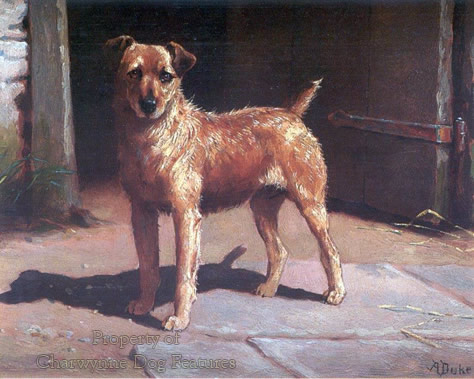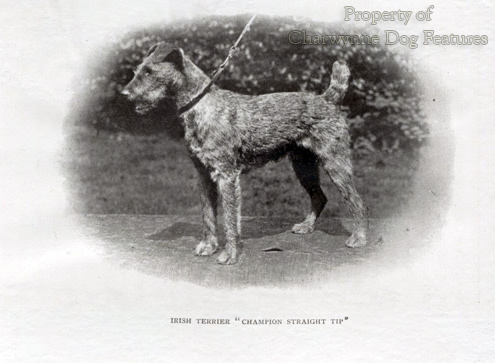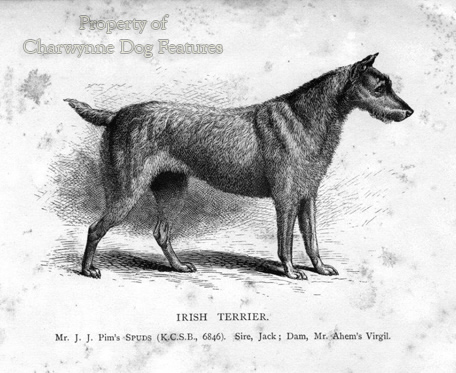746 ADMIRING THE IRISH TERRIER
ADMIRING THE IRISH TERRIER
by David Hancock
 The Irish Terrier has earned itself a reputation the world over for almost reckless dash and an unquenchable spirit, in many ways epitomising the dare-devil nature of Irishmen themselves. There is a telling very Irish phrase, which expresses, with whimsical understatement, that the Irish Terrier is averse to anyone ‘treading on his coat’. For many years a fearsome red-coated cropped-eared very sharp terrier defended many a paddy’s patch against intruding pigs, wandering goats and marauding curs, as well as keeping the inevitable rat population within bounds. But the breed was not always favoured in a red jacket. Killiney Boy, the founder sire of the breed, had a black and tan dam; two early champions, Bachelor and Benedict, were from a litter of one grey, three red and five black and tan pups and one of three red and five black and tan pups respectively. At Belfast in 1876, a dog named Slasher was unbeatable, being described as a ‘pure old white Irish terrier, a splendid field and water dog’. Killiney Boy, incidentally, lived to a ripe old age, but, predictably for him, lost his life in a free-for-all kennel fight.
The Irish Terrier has earned itself a reputation the world over for almost reckless dash and an unquenchable spirit, in many ways epitomising the dare-devil nature of Irishmen themselves. There is a telling very Irish phrase, which expresses, with whimsical understatement, that the Irish Terrier is averse to anyone ‘treading on his coat’. For many years a fearsome red-coated cropped-eared very sharp terrier defended many a paddy’s patch against intruding pigs, wandering goats and marauding curs, as well as keeping the inevitable rat population within bounds. But the breed was not always favoured in a red jacket. Killiney Boy, the founder sire of the breed, had a black and tan dam; two early champions, Bachelor and Benedict, were from a litter of one grey, three red and five black and tan pups and one of three red and five black and tan pups respectively. At Belfast in 1876, a dog named Slasher was unbeatable, being described as a ‘pure old white Irish terrier, a splendid field and water dog’. Killiney Boy, incidentally, lived to a ripe old age, but, predictably for him, lost his life in a free-for-all kennel fight. 
Bachelor was a noted sire of winning bitches but his critics described him as a red Fox Terrier. A well known sportsman and prominent terrierman of that time, Major Harding Cox did in fact put a Wire-haired Fox Terrier bitch of his Newboy strain to him; and with litter sisters from this cross won a second in Wire-haired Fox Terriers and a third in Welsh Terriers. So much for the sanctity of the pedigree and the accompanying worship of breed purity! Show exhibits nowadays have to be purebred before their quality is even examined
Two hundred years ago a litter of terrier pups in Ireland could contain coat colours ranging from black and grey, red and tan to silver and gold, wheaten and white. At the first show, in Dublin in 1874, featuring Irish Terriers, one winner was white, another black and tan and another grizzled blue. Selective breeding based on breeder and locality preferences concentrated the colour genes of terriers in Ireland into distinct groups that were perpetuated. Breeds reflected those preferences. Dr Carey, first president of the Irish Terrier Club, wrote in 1879, on colour: "Red yellow, wheaten or light brown inclining to grey. The best colour is orange tipped with red, the head slightly darker than the body and the ears slightly darker than the head.. ." The standard for the Irish Terrier today demands a 'whole-coloured' dog, with black shading highly undesirable. Writing in Compton’s The Twentieth Century Dog of 1904, CJ Barnett was remarking: “Thirty years ago there were many black and red terriers in Ireland, with very hard coats, but of course were not bred from. I only wish we had kept to it, and not thrown out the old blacks, as their coats were very, very hard.” It would be so good to see a really hard-coated black Irish Terrier once again. 
In Drury’s British Dogs of 1903 and in Vero Shaw’s The Illustrated Book of the Dog of 1879, the Irish Terrier’s prowess as a rabbit-dog is spelt out. In the former it states: “Without question, rabbiting is the kind of sport that the Irish Terrier excels at – the right dog in the right place, so to speak. A model Irish Terrier is a miniature Irish Wolfhound with a yellow-red coat, and, consequently, being built on these racy lines, he is by nature specially adapted for rabbiting in every way.” In the latter, it states: ”Looking at them as workmen, rabbiting must first be mentioned…Rely upon it, their quick noses never make a mistake…It is only when one sees them at full speed that one can understand the necessity for insisting upon their peculiar build.” I always think of the terriers of Ireland as all-rounders, ready to pursue a chosen quarry, herd cattle or even sheep, go ratting in a barn or act as farm watch-dogs.
For some years size was the great issue in this breed. Today the Kennel Club standard requires an ideal height for dogs of 19 inches and for bitches of 18 inches. In the early twentieth century, dogs weighing as much as 40lbs were found on the benches and the wide variation (from the 16lb minimum) led to deterioration; one breed critic composing poetry which included: ‘It’s wonderful dogs they’re breeding now, Small as a flea or large as a cow…’ In 1908 well over 700 Irish Terriers were registered with the KC; in the 1920s the annual average was over a thousand. But in 1982 only 130 were registered, followed by an increase to 271 in 2007, then 369 a year later. Show ring judges in recent years have criticised the lack of muscle tone, a weakness in pastern and loose front movement in the entry, not good news. The Irish Terrier is a breed with few inherited problems, although eye conditions do occur, as does the relatively rare horny growths on the footpads. The breed is one of the 14 breeds having a predilection to cystine stones in male dogs. 
Perhaps the raciest terrier in build, with a visible tuck-up and slight arch over the loins. I don’t like the shorter back being favoured by some kennels recently or the lack of substance in some exhibits. A lack of muscle in any terrier is a travesty but in a racy dog it looks as though the dog has been half-starved. Pierce O’Conor in his Sporting Terriers of 1926 described the breed briefly but admiringly, writing: “I have always found this sort to have much better noses and hunt thick cover much better than the larger dogs.” Lucas, in his Hunt and Working Terriers of 1931, doesn’t cover the breed but it is the case that northern working terriers owed much to the Irish Terrier, as Brian Plummer points out in his The Sporting Terrier. The Border, Lakeland, Fell, Dandie Dinmont and the Bedlington are all believed to have been bred to stock brought over from Ireland, just as terriers in Ireland were influenced by terriers from England introduced by garrison sportsmen there in the 18th and 19th centuries. Plummer mentioned the use of the breed in the production of lurchers, valuing the Irish Terriers mute hunting tendency.
It is not difficult to admire this breed; it has natural gameness, a relatively healthy genotype, an unexaggerated phenotype and has never been over-bred. Although not often seen at working terrier shows, I have heard of their making excellent bushing dogs and outstanding hunters in water. Their reputation on ground vermin is well-earned. The breed has long been a favourite in the United States, but I don’t favour the treatment to the coat given to their show ring exhibits. Sporting terriers just don’t look right when shaped by the groomers. For me show judges are just not hard enough on poor quality exhibits; no contemporary judge would write this rather outspoken critique on Irish Terriers at the Kennel Club’s Show at Olympia, July, 1889: 
“Irish Terriers - Champion Dogs: B.A. (first), grand head, expression, good body, and a better height on the leg than Michael (second) with his fair head and character, softish coat of better colour than the winner; they are both ‘awful’, worst feet I ever saw. Ballyhooley (reserve) all wrong in head and character, grand legs and feet and hard coat. St. George, soft in expression, coat, bad in loin with good front. Begum, common and too thick, good in coat…” And no dog magazine of today would publish this type of hard-hitting comment from British Dogs by WD Drury, Upcott Gill, 1903:
“The modus operandi of a novice is too frequently to purchase from some unscrupulous person a snipy-faced , weedy little bitch, or a big, ungainly, flaxen-coated specimen of very doubtful blood, that bears no affinity to an Irish Terrier, except perhaps in colour, and then plank down his money for the service of a stud dog of totally different outline and character, in the full expectation that the mating will strike the happy medium in the size and quality of the progeny, simply because the sire is a good dog. This is diametrically opposed to the laws of practical breeding, and only brings sad disappointment to the experimenter, wastes his time and money, and stocks the country with mongrels thatshould never see the light of day.” More’s the pity! If we are to breed top class dogs, breeders need to face reality. The Irish Terrier has some good breeders and their dogs deserve a wider audience.